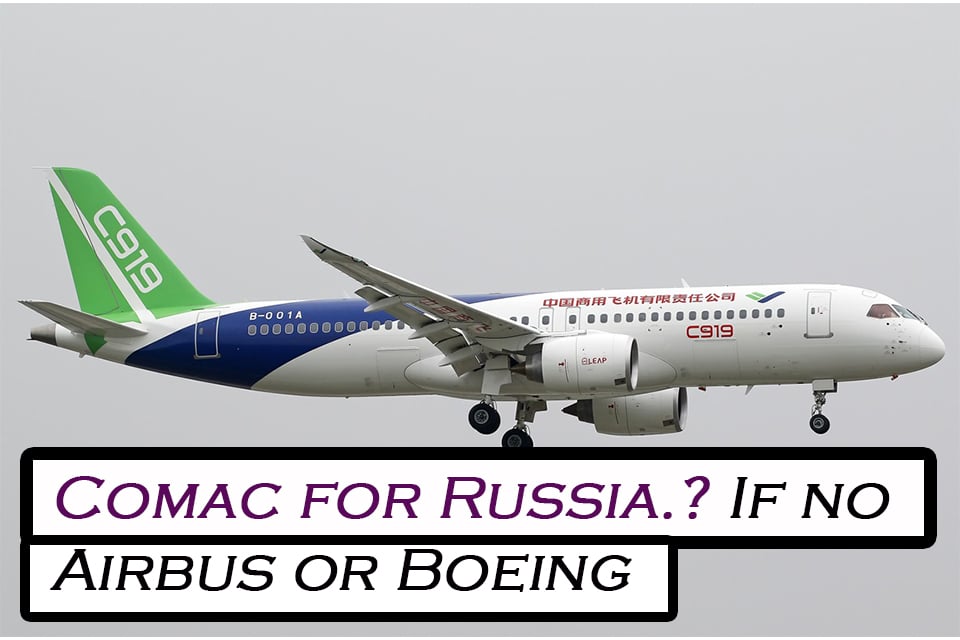Aerospace
Russia might pick COMAC if there are no western aircraft?

- Russia facing shortage of parts without the necessary technical assistance, Airbus and Boeing aircraft may not be usable and will remain on the ground.
- Russia will turn to China for new economic alliances as a result of its growing isolation from the West.
- Russia has historically competed fiercely with western nations, but it has tried to develop its own, reliable products.
Russia has experienced a significant halt in using any product made in the West as the invasion of Ukraine continues. Because they don’t have any service or parts support and all the items are useless to them, Russia may be under pressure to use any aviation aircraft.
However, according to a recent source, they have a great buddy in China who may assist Russia in producing products for western aircraft. However, as this assistance may not be long-term reliable, Russia may need to consider purchasing new aircraft, either domestically produced or imported. so that it might select a comac C919 Aircraft made in China.
According to a source, Russia is now using 17% domestically constructed aircraft, but the majority of airlines rely on foreign aircraft made by Boeing and Airbus. however, without the necessary technical assistance, these aircraft may not be usable and will remain on the ground. However, given the current circumstances, Russia might opt for another aircraft.
There has been a slight comeback, and there are numerous successful tales of Russia that demonstrate the strength of its aviation products, which are best known for their use in defence products and other products like the Sukhoi Superjet 100, which is a regional jet. The Irkut MC-21, a narrow-body aircraft, is expected to become the nation’s first serious competitor to the Airbus A320 and Boeing 737 later this year.
Russia will turn to China for new economic alliances as a result of its growing isolation from the West. An excellent example is the aviation industry, which has been severely harmed by sanctions and is forced to intensify its cooperation with its significant neighbor to the East.
If they decide on the Comac C919 aircraft, it will be harder for Russia because the majority of Comac’s components were made in the West. The engine is currently a CFM International LEAP-1C. Developing a Chinese engine to replace the CFM Leap-1C would take at least another 10 years. The majority of the avionics subsystem and other companies are Western-developed.
Currently, no Russian companies have placed any orders for Comac, but if the Comac C919 begins to deliver positive results, they may do so in the future. Even if they do so, it will be difficult for China Comac to satisfy the demands. It must have the supplier’s consent before selling aircraft. Russia may then decide to fund and participate in the development of the Comac C919 aircraft.
Russians are experts in some aeronautical terms, yet even they criticize western nations. However, the circumstances might push them to create their own, and now China might also join the project. However, if the two nations join forces and begin developing aircraft, it will be more difficult for western nations affected by aircraft orders. If the difficult scenario persists, Russia will have to put in a lot of effort and develop new products to meet its need for airlines.
Please share your thoughts with us about Russia’s position concerning Comac aircraft.

Aerospace
When Ratan Tata was denied entry to the airfield at the Aero India show, he waited

During our visit to Aero India 2019, we had the unexpected opportunity to see Ratan Tata at the event, which was a thrilling moment for us. However, there was a surprising hiccup when the security staff didn’t allow him to enter due to a lack of a security pass.
Despite this, he remained calm and patiently waited for about 20 minutes until a member of the Tata team brought him the required pass, after which he calmly proceeded inside. It was a humbling sight, showcasing his composed demeanor even in such situations.
Ratan Tata ji is not only a renowned industrialist but also a trained pilot, holding a pilot’s license. In 2007, he became the first Indian civilian to fly the F-16 Falcon during the Aero India show in Bangalore—a proud moment for the nation.
His passion for aviation extended beyond flying, as he played a key role in shaping India’s aerospace industry. Under his leadership, Tata ventured into manufacturing and maintaining aerospace components while upholding its legacy of quality. Notably, Tata’s collaboration with Airbus to develop and manufacture the C295 aircraft is a testament to its growing influence in the sector.
-

 Aviation2 months ago
Aviation2 months agoMicrosoft Flight Simulator Raises $3 Million to Bring Back the An-225 Mriya
-

 Airlines2 months ago
Airlines2 months agoQatar Citizens Can Travel to the United States Without a Visa
-

 Aviation2 months ago
Aviation2 months agoQatar Airways bans these new Electronic Devices on plane
-

 Airlines2 months ago
Airlines2 months agoJapan Airlines Rolls Out Free Domestic Flights to International Passengers
-

 Travel2 months ago
Travel2 months agoQatar Airways Launches Four Additional Flights from Amsterdam
-

 Defence2 months ago
Defence2 months agoWhich Country Has the Largest Fleet of Fighter Aircraft?
-

 Airport2 months ago
Airport2 months agoWestern Sydney Airport Welcomes Its First Plane After 6 Years of construction
-

 Airlines4 days ago
Airlines4 days agoDAMAC Air: Dubai’s New Luxury Airline Offers Free Flights for Registration








